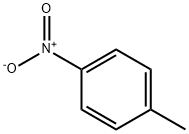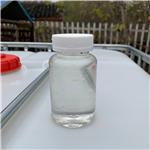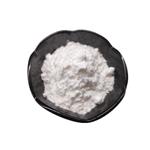Nitrotoluene is formed in 3 isomeric forms.
The o-and m-forms are yellow liquids or solids. The p-form
is a pale yellow crystalline solid. All have weak aromatic
odors. The Odor Thresholds are: 0.05 mg/L (o-isomer);
1.74 ppm (m-isomer).
used in the synthesis of
dyestuffs, explosives, and agricultural chemicals
4-Nitrotoluene is an explosive material.
manufacture of dyes, toluidines, nitrobenzoic acids, agricultural and rubber chemicals.
ChEBI: 4-nitrotoluene is a mononitrotoluene that consists of toluene bearing a nitro substituent at the 4-position.
After distillation of the meta fraction from the isomer mixture, the still residues are cooled in a crystallizer to separate technical quality 4-nitrotoluene. Further distillation of nitrotoluene residues and fractions should be implemented with great care because this has been reported to cause explosions.
A yellow liquid with a weak aromatic odor. Toxic. Insoluble in water. Combustible but may take some effort to ignite. Produces toxic oxides of nitrogen when burned. In a spill, immediate steps should be taken to limit its spread to the environment. Can easily penetrate the soil and contaminate groundwater or nearby streams. Used to make other chemicals.
4-Nitrotoluene may react violently with sodium, tetranitromethane, strong oxidizing agents , sulfuric acid and other acids.
Toxic by inhalation, ingestion, skin absorption. Methemoglobinemia. Questionable carcinogen.
INHALATION, INGESTION, OR SKIN: Headache, flushed face, dizziness, dyspnea (difficult breathing), cyanosis, nausea, vomiting, muscular weakness, rapid pulse and respiration, irritability, and convulsions.
Special Hazards of Combustion Products: Yields toxic oxides of nitrogen when burning.
A poison. Moderately
toxic by ingestion, inhalation, and
intraperitoneal routes. Mildly toxic by skin
contact. Mutation data reported.
Combustible when exposed to heat or
flame. To fight fire, use CO2, dry chemical,
foam. The residue from vacuum distillation
may explode spontaneously. Reacts with
sodmm to form an ignitable product.
Violent reaction with concentrated sulfuric
acid (above 16O°C), sulfuric acid + sulfur
trioxide (above 52°C). Mixtures with
tetranitromethane are sensitive high
explosives. May explode on standing. It has
been involved in plant scale explosions.
When heated to decomposition it emits
toxic fumes of NOx. See also other
methylnitrobenzene entries and NITRO
COMPOUNDS OF AROMATIC
HYDROCARBONS.
The nitrotoluenes are used in the
production of toluidines and other dye intermediates.
All isomers are used in manufacture of agriculture and
rubber chemicals and in various dyes.
Biological. Under anaerobic conditions using a sewage inoculum, 3- and 4-nitrotoluene both
degraded to toluidine (Hallas and Alexander, 1983). Robertson et al. (1992) reported that toluene
dioxygenases from Pseudomonas putida F1 and Pseudomonas sp. Strain JS 150 oxidized the
methyl group forming 2-methyl-5-nitrophenol and 3-methyl-6-nitrocatechol.
Chemical. Though no products were identified, 4-nitrotoluene (1.5 x 10-5 M) was reduced by
iron metal (33.3 g/L acid washed 18 to 20 mesh) in a carbonate buffer (1.5 x 10-2 M) at pH 5.9 and
15 °C. Based on the pseudo-first-order disappearance rate of 0.0335/min, the half-life was 20.7
min (Agrawal and Tratnyek, 1996).
UN1664 Nitrotoluenes, (o-; m-; p-), Hazard
Class: 6.1; Labels: 6.1-Poisonous materials.
Dry it in air, then dry it in a vacuum desiccator over H2SO4. [Wright & Grilliom J Am Chem Soc 108 2340 1986, Beilstein 5 IV 848.]
Decomposes on contact with strong oxidizers;
strong acids; reducing agents; strong bases; ammonia,
amines producing toxic fumes, causing fire and explosion
hazard. Heat above 190�C may cause explosive decomposition.
Attacks some plastics, rubbers, and coatings.
Controlled incineration-care
must be taken to maintain complete combustion at all
times. Incineration of large quantities may require scrubbers
to control the emission of nitrogen oxides.



